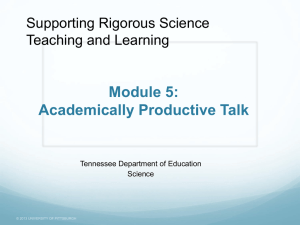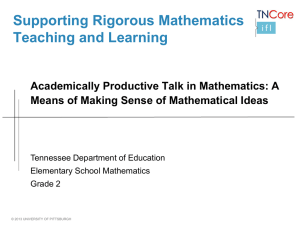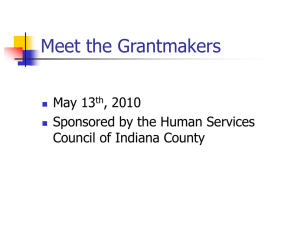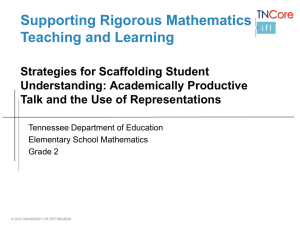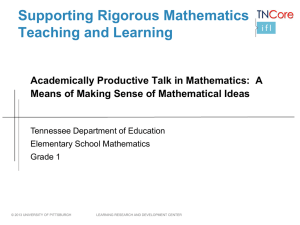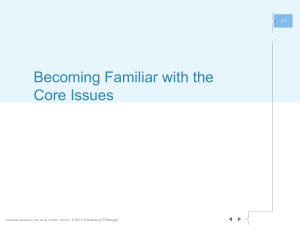Accountable Talk Features and Indicators
advertisement
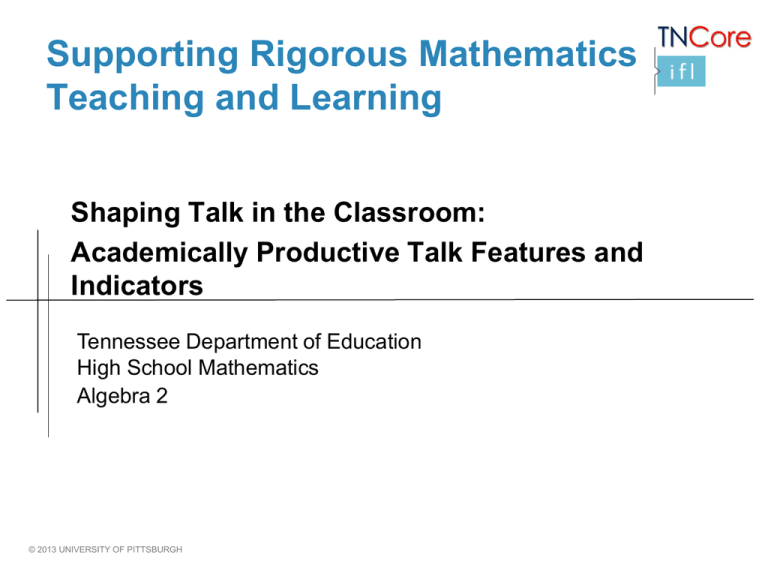
Supporting Rigorous Mathematics Teaching and Learning Shaping Talk in the Classroom: Academically Productive Talk Features and Indicators Tennessee Department of Education High School Mathematics Algebra 2 © 2013 UNIVERSITY OF PITTSBURGH Rationale Teachers’ questions are crucial in helping students make connections and learn important mathematics and science concepts. Teachers need to know how students typically think about particular concepts, how to determine what a particular student or group of students thinks about those ideas, and how to help students deepen their understanding (Weiss & Pasley, 2004). By analyzing a transcript of an Accountable Talk® discussion, participants will consider the benefits to student learning when the Accountable Talk features and indicators are present in the Share, Discuss, and Analyze Phase of the lesson. Accountable Talk® is a registered trademark of the University of Pittsburgh. Session Goals Participants will: • learn about Accountable Talk features and indicators; and • learn about the benefits of using indicators of all three Accountable Talk features in a classroom discussion. © 2013 UNIVERSITY OF PITTSBURGH Overview of Activities Participants will: • analyze transcripts, identify Accountable Talk features and indicators, and consider the benefits of fostering this community; and • plan for an Accountable Talk discussion. © 2013 UNIVERSITY OF PITTSBURGH Accountable Talk Features and Indicators • Read the list of Accountable Talk indicators related to each of the features. Accountability to the Learning Community Accountability to Knowledge Accountability to Rigorous Thinking • How do the features differ from one another? © 2013 UNIVERSITY OF PITTSBURGH Accountable Talk Features and Indicators Accountability to the Learning Community • Actively participate in classroom talk. • Listen attentively. • Elaborate and build on each others’ ideas. • Work to clarify or expand a proposition. © 2013 UNIVERSITY OF PITTSBURGH Accountable Talk Features and Indicators Accountability to Knowledge • Specific and accurate knowledge • Appropriate evidence for claims and arguments • Commitment to getting it right © 2013 UNIVERSITY OF PITTSBURGH Accountable Talk Features and Indicators Accountability to Rigorous Thinking • Synthesize several sources of information. • Construct explanations and test understanding of concepts. • Formulate conjectures and hypotheses. • Employ generally accepted standards of reasoning. • Challenge the quality of evidence and reasoning. © 2013 UNIVERSITY OF PITTSBURGH Accountable Talk Discussion Turn and Talk with your partner about what you would expect teachers and students to be saying during an Accountable Talk discussion for each of the features. − accountability to the learning community − accountability to accurate, relevant knowledge − accountability to discipline-specific standards of rigorous thinking © 2013 UNIVERSITY OF PITTSBURGH Accountable Talk Features and Indicators Indicators of all three Accountable Talk features need to be evident in a lesson. Lessons should be: • accountable to the learning community; • accountable to knowledge; and • accountable to rigorous thinking. Why might it be important to have Indicators of all three features of Accountable Talk discussions in a conversation? © 2013 UNIVERSITY OF PITTSBURGH Preparing for the Share, Discuss, and Analyze (SDA) Phase of the Lesson © 2013 UNIVERSITY OF PITTSBURGH The Structures and Routines of a Lesson Set Up of the Task The Explore Phase/Private Work Time Generate Solutions The Explore Phase/Small Group Problem Solving 1. Generate and Compare Solutions 2. Assess and Advance Student Learning Share, Discuss, and Analyze Phase of the Lesson 1. Share and Model 2. Compare Solutions 3. Focus the Discussion on Key Mathematical Ideas 4. Engage in a Quick Write © 2013 UNIVERSITY OF PITTSBURGH MONITOR: Teacher selects examples for the Share, Discuss, and Analyze Phase based on: • Different solution paths to the same task • Different representations • Errors • Misconceptions SHARE: Students explain their methods, repeat others’ ideas, put ideas into their own words, add on to ideas and ask for clarification. REPEAT THE CYCLE FOR EACH SOLUTION PATH COMPARE: Students discuss similarities and difference between solution paths. FOCUS: Discuss the meaning of mathematical ideas in each representation REFLECT: By engaging students in a quick write or a discussion of the process. Triple Trouble Consider the two functions graphed below. Let ℎ 𝑥 = 𝑓(𝑥) ∙ 𝑔(𝑥) 1. David, Theresa, Manuel, and Joy are working in a group together to determine the key characteristics of h(x). They each make a prediction. Decide whether you agree or disagree with each student’s prediction. Use mathematics to justify your position. • David: h(x) will be a parabola. • Theresa: h(x) will have a y-intercept at (0, 12). • Manuel: h(x) will have negative y-values over the interval −2 ≤ 𝑥 ≤ −1. • Joy: h(x) will have three x-intercepts. 2. Sketch a graph of h(x) on the coordinate plane. Then identify key characteristics of the graph (zeros, y-intercept, max/min values, end behavior) and explain how each key characteristics results from key characteristics of f(x) and g(x). 3. Determine the equation of h(x). Justify your answer in terms of f(x) and g(x). © 2013 UNIVERSITY OF PITTSBURGH The CCSS for Mathematical Content CCSS Conceptual Category – Algebra 2 Building Functions (F-BF) Build a function that models a relationship between two quantities F-BF.A.1 Write a function that describes a relationship between two quantities.★ F-BF.A.1b Combine standard function types using arithmetic operations. For example, build a function that models the temperature of a cooling body by adding a constant function to a decaying exponential, and relate these functions to the model. Arithmetic with Polynomials and Rational Expressions (A-APR) Understand the relationship between zeros and factors of polynomials A-APR.B.3 Identify zeros of polynomials when suitable factorizations are available, and use the zeros to construct a rough graph of the function defined by the polynomial. ★Mathematical Modeling is a Standard for Mathematical Practice (MP4) and a Conceptual Category, and specific modeling standards appear throughout the high school standards indicated with a star (★). Where an entire domain is marked with a star, each standard in that domain is a modeling standard. Common Core State Standards, 2010 The CCSS for Mathematical Practice 1. Make sense of problems and persevere in solving them. 2. Reason abstractly and quantitatively. 3. Construct viable arguments and critique the reasoning of others. 4. Model with mathematics. 5. Use appropriate tools strategically. 6. Attend to precision. 7. Look for and make use of structure. 8. Look for and express regularity in repeated reasoning. Common Core State Standards, 2010 Analyzing Student Work Use the student work to further your understanding of the task. Consider: • What do the students know? • How did the students solve the task? • How do their solution paths differ from each other? © 2013 UNIVERSITY OF PITTSBURGH Group A © 2013 UNIVERSITY OF PITTSBURGH Group B © 2013 UNIVERSITY OF PITTSBURGH Group C © 2013 UNIVERSITY OF PITTSBURGH Group D © 2013 UNIVERSITY OF PITTSBURGH Group E © 2013 UNIVERSITY OF PITTSBURGH 21 Selecting Students’ Work The teacher selected work from Groups B and C for the Share, Discuss, and Analyze Phase of the lesson. Consider the following: • Why might the teacher have chosen these pieces of student work for this lesson phase? • What mathematical concepts can be targeted by the teacher using the student work that s/he chose? © 2013 UNIVERSITY OF PITTSBURGH Analyzing Teaching and Learning Triple Trouble Task Vignettes: Two classrooms are solving and discussing solution paths to the Triple Trouble Task. • Read a short transcript from Classroom A and Classroom B. • What are students learning in each classroom? © 2013 UNIVERSITY OF PITTSBURGH Analyzing Teaching and Learning What is similar and different between the opportunities to learn in Classroom A and Classroom B? © 2013 UNIVERSITY OF PITTSBURGH The Share, Discuss, and Analyze Phase of the Lesson What made it possible for this learning to occur? © 2013 UNIVERSITY OF PITTSBURGH Accountable Talk Features and Indicators Which of the Accountable Talk features and indicators were illustrated in the transcript from Teacher A’s classroom? © 2013 UNIVERSITY OF PITTSBURGH The Share, Discuss, and Analyze Phase of the Lesson • In what ways did students engage in an Accountable Talk discussion? • What purpose did the Accountable Talk features serve in the lesson? © 2013 UNIVERSITY OF PITTSBURGH 27 Your Turn Consider the essential understanding below: The product of two or more linear functions is a polynomial function.The resulting function will have the same x-intercepts as the original functions because the original functions are factors of the polynomial. What would you need to hear from students to know that they had this understanding? © 2013 UNIVERSITY OF PITTSBURGH Your Turn At your tables, plan questions and possible student responses for a classroom discussion that will get at the essential understanding. How will you hold them accountable to the learning community, knowledge, and rigorous thinking? © 2013 UNIVERSITY OF PITTSBURGH Your Turn • What did you notice about planning questions and anticipating student responses? • What are some things you said and did to hold students accountable to the learning community, knowledge, and rigorous thinking? © 2013 UNIVERSITY OF PITTSBURGH Step Back: Reflecting on the Benefits What are the benefits of using Accountable Talk features and indicators as a tool for reflecting on the classroom discussion? For planning? © 2013 UNIVERSITY OF PITTSBURGH

